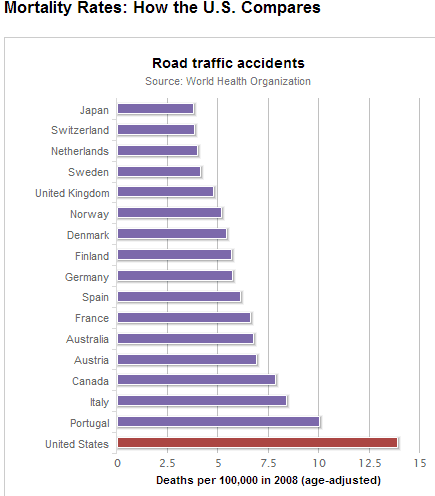Distracted driving is defined as the “diversion of attention away from activities critical for safe driving toward a competing activity”.
Examples of such competing tasks are eating, adjusting the radio and talking to passengers. Furthermore, the use of electronic devices such as cell phones while driving has received much attention lately.
Dialing or talking on a cell phone or sending and receiving text messages is most common among young drivers (15-24 years old).
The Statistics
Every day, thousands of people are killed and injured in road traffic accidents.
Men, women or children, walking, biking or riding to school or work, or playing in the streets will never return home, leaving behind shattered families and communities. Many of those who survive will never be able to live, work or play as they used to do.
Tragically, more than half of the people killed in traffic crashes are young adults aged between 15 and 44 years.
Road traffic injuries are the eighth leading cause of death, and as such are an important global public health problem. They are the number one cause of death among those aged 15-29 years. There were approximately 1.24 million road traffic deaths in the world in 2010, 77% of which were among males.
Middle-income countries had the highest burden and the highest road traffic death rates. In the United States more than 40,000 people are killed and millions are treated in hospital emergency departments each year.

In the 1960’s about 8.000 people were killed each year in traffic collisions on the roads in Great Britain. In Canada the yearly fatality rate was reduced from 3,445 to 2,011 between 1990 and 2009. Although the same trend is seen in the United States., the death rate from traffic crashes is still surprisingly high compared to many other high income countries (see figure on right).
Despite these positive results we still have a long way to go. What is more important, we all have to take responsibility. In order to protect ourselves and our fellow citizens it is essential that we don’t adopt behaviors that increase the risk of accidents.
Distracted Driving
Distracted driving was recently addressed in a scientific paper published by Klauer and coworkers in the New England Journal of Medicine. In the study, U.S. and Canadian researchers studied the risk of performing a secondary task while driving.
The researchers, at the Virginia Tech Transportation Institute installed video cameras, global positioning systems, lane trackers, gadgets to measure speed and acceleration, and other sensors in the cars of study participants.
Previous studies have shown that cell phone use while driving leads to a fourfold increase in the risk of crash among experienced drivers. These studies also indicated that using a hand free phone is not safer.
The study by Klauer and coworkers showed that talking on a cell phone was not associated with a significant increase in the risk of crash. However dialing, reaching for a cell phone, texting, reaching for an object other than a cell phone, looking at a roadside object, and eating were all associated with an increased risk of a crash or near-crash.
Compared to periods when they weren’t distracted, the odds of of a young driver getting into a crash or near-crash were 8.32 higher when they were dialing a cellphone; 8 times higher when reaching for something besides their cellphone; 7.05 times higher when trying to grab the phone; 3.9 times higher when looking at something on the side of the road; and 2.99 times higher when eating.
Although talking on a cell phone was not directly associated with increased risk, the authors point out that talking can rarely be accomplished without reaching for it and dialing the phone or answering calls, all of which are likely to take the driver’s eyes off the road.
A Simple Decision Can Save Lives

We, motor vehicle drivers, often forget our responsibility when it comes to safety on the roads. It’s a fact that more than half of road crashes are due to driver factors. We tend to forget that lives of people often change in an instant, it only takes a fraction of a second. The lack of irreversibility of such an event is cruel and shocking. It often hunts people for the rest of their lives.
We have to drop the “It won’t happen to me or my close ones” attitude. By not touching our cell phones while driving we can cut the risk of accidents. Such a simple decision may help save lives and prevent tragedies that might otherwise lead to lifetime suffering for us, other people, families and communities. Education is the key.
advertisement
Discover more from Doc's Opinion
Subscribe to get the latest posts sent to your email.


In Australia it is a chargeable offence to drive while texting, making or receiving a call on a mobile phone…….
I expect this does not include wearing some form of audio device…… ear piece etc…. but does include using hands to operate